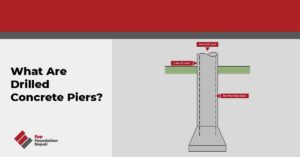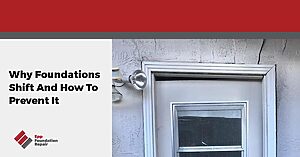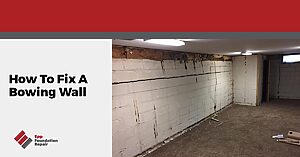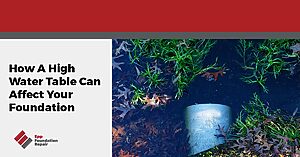Searching for information on drilled concrete piers? If so, you’ve landed on the right page. In this article we’re going to go over the basics of drilled concrete piers including what they are, when they’re used, how they’re installed, and more.
What Are Drilled Concrete Piers?
Drilled concrete piers are used to construct deep foundation systems. They transfer a structure’s load to soil or bedrock that’s able to adequately support it.
A drilled concrete pier consists of a drilled shaft, reinforcing steel, and concrete. Other names for drilled concrete piers include cast-in-situ piles, cast-in-drilled-hole piles, drilled shafts, and caissons.
Drilled concrete piers can be installed in all soil types.

When Are Drilled Concrete Piers Used?
Possible applications of drilled concrete piers include:
- Repairing foundations that are experiencing lateral movement or differential settlement due to downhill creep – Downhill creep (also called soil creep) is when the soil at the top of a hill slowly makes its way down the hill. Downhill creep is a type of erosion and as the structure’s foundation moves laterally, various problems will develop. These include cracks in walls, ceilings, or floors, windows and doors that no longer open and close properly, uneven floors, etc. Drilled concrete piers will stop lateral and horizontal movement and stabilize the foundation.
- Construction on top of expansive soil – Expansive soil contains a lot of clay and because of this, it expands when it soaks up moisture and shrinks when it dries out. Therefore, it isn’t suitable for construction. This means you’ll need a deep foundation system that goes down to soil or bedrock that’s able to support the structure.
- Construction on top of erosion-prone soil
- Construction on top of weak soil
Other applications for drilled concrete piers include commercial buildings, retaining walls, and bridges.
How Are Drilled Concrete Piers Installed?
The installation of a drilled concrete pier is a 3-stage process:
- Excavation – A hole is drilled in the ground and soil excavated. Usually, an auger drill is used. When the drill is full of soil, it’s lifted up, and the soil is removed. If a belled pier is necessary because the soil is weak, the necessary bell shape will be created using a special tool. Geotechnical engineers determine how deep the hole needs to be.
- Reinforcing steel is added for support
- Concrete is poured into the hole – Once the reinforcing steel is in place, the concrete is poured in. It takes about a month for the concrete to dry and harden. After that, the pier will be able to resist both vertical and lateral stresses.
Benefits Of Drilled Concrete Piers
The benefits of drilled concrete piers include:
- One drilled pier can support a lot of weight, both vertical and lateral loads
- Good for construction in expansive soil
- Construction doesn’t make a lot of noise
- They can be used in rocky soil and bedrock
- Piers can be any size or depth
- Good for making sure structures can withstand earthquakes
What Causes Most Foundation Problems?
Differential settlement is the cause of most foundation problems. This is when a foundation settles into the ground unevenly. Differential settlement puts a lot of stress on a foundation and this can lead to severe structural damage.
But, what causes differential settlement? There are numerous causes, but the most common are:
- Expansive soil – Expansive soil is probably the most common cause of foundation trouble. As we mentioned above, expansive soil swells when it soaks up moisture and then shrinks when it dries out. This swelling-shrinking cycle – which is usually seasonal – puts considerable stress on a foundation and can lead to differential settlement.
- Inadequate soil preparation – Soil needs to be tamped down before anything gets constructed on top of it. If this isn’t done properly, the foundation will settle into the soil after it’s built and you could end up with differential settlement.
- Heavy excavation next to the foundation – If someone digs a big hole next to your home, it could destabilize the foundation leading to differential settlement.
- Earthquakes and other natural disasters – We probably don’t need to explain this one.
- Weather changes – An example of this would be building a house on top of expansive soil during the dry season. When the wet season rolls around again, the soil swells and this causes differential settlement.

How You Can Prevent Foundation Problems
Since expansive soil is a leading cause of foundation trouble – no matter the type of foundation – you can do a lot to prevent problems by simply getting groundwater under control around the foundation. Your goal here is make sure the soil around the foundation doesn’t get saturated with water. Here are a few ways to do that:
- Clean your gutters regularly – You don’t want runoff spilling over the gutters, running down the side of the house, and soaking the ground around the foundation.
- If necessary, regrade your yard so it slopes away from the foundation – This will prevent water from draining toward the foundation.
- Use downspout extensions – You don’t want short downspouts releasing water next to the foundation. Extensions are inexpensive, easy to install, and will carry water away from the foundation before releasing it.
- Install an underground downspout along with a pop-up emitter – Runoff flows into the underground downspout and toward a pop-up emitter situated somewhere in your yard around 10 feet from the foundation. When the emitter fills with water, it pops up and expels it away from the foundation.
- Don’t plant flowers, shrubs, etc., next to the foundation – You don’t want to give yourself a reason to add water to the ground around the foundation.
- Install a drain tile system – This is the best foundation waterproofing method available today. To find out how it works see, The Importance Of Proper Foundation Drainage Around Your Home.
If you think your home might have a foundation problem requiring the possible use of drilled concrete piers, contact us today for a foundation evaluation. We serve areas in Nebraska, Iowa, Kansas, and Missouri.







